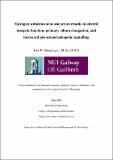| dc.description.abstract | Osteocytes are the main mechanosensitive cells within bone. They detect changes in the mechanical environment and transduce them into biochemical responses (RANKL, OPG, and sclerostin) that regulate bone remodelling by osteoblasts and osteoclasts. Osteocytes have specialised mechanosensory transmembrane proteins and biomolecules, in particular integrins for mechanosensation of matrix strains and primary cilia for sensation of fluid shear stress. Circulating estrogen levels are depleted during post-menopausal osteoporosis and a recent in vitro study demonstrated that osteocytes exhibit diminished responses to mechanical stimulation following estrogen withdrawal. However, these responses are not yet fully understood. In particular, it is not yet known whether these altered responses arise as a result of changes in mechanosensation and mechanotransduction, or whether they play a role in the overall bone loss cascade. The global objective of this thesis is to understand the effect of estrogen withdrawal on osteocyte mechanosensor function and how this relates to paracrine regulation of osteoclasts.
The first study of this thesis sought to determine the role of αvβ3 integrins in osteocyte mechanotransduction during estrogen withdrawal. Following three days of estrogen treatment, MLO-Y4 osteocytes were cultured for a further two days in normal media to simulate estrogen withdrawal. The results of this study revealed that following estrogen withdrawal, osteocytes have smaller focal adhesions, with reduced αvβ3 localisation, compared to estrogen treated cells, and an increased Rankl/Opg ratio. Osteocytes that were mechanically stimulated by oscillatory fluid shear stress following estrogen withdrawal demonstrated a defective Cox-2 response to flow, compared to estrogen treated cells. Interestingly, osteocytes that had the integrin αvβ3 blocked using an antagonist also have disrupted focal adhesions and abrogated Cox-2 responses to oscillatory fluid flow. Taken together, these results provide the first evidence for a relationship between estrogen withdrawal and defective αvβ3-mediated signalling. Specifically, this study implicates estrogen withdrawal as a putative mechanism responsible for altered αvβ3 expression and resultant changes in downstream signalling in osteocytes during post-menopausal osteoporosis, which might provide an important, but previously unidentified, contribution to the bone loss cascade.
The second study sought to understand the effect of estrogen withdrawal on primary cilium dynamics and primary cilia related Hedgehog signalling. Similar to the first study, osteocytes were cultured under a regime of estrogen withdrawal, but under static conditions alone. Firstly, it was reported that the primary cilium was lengthened in cells after a period of estrogen withdrawal, and this was associated with increases in Hedgehog signalling markers, Ptch1 and Gli1, and an increased Rankl/Opg ratio. The role of actin contractility and focal adhesion assembly in the altered cilia length and associated signalling was investigated. Significant inverse relationships were identified linking increased cilia lengths with a lower cell area and lower % focal adhesion area/cell area. Interestingly, antagonism of the integrin αvβ3 resulted in an elongation of the primary cilium and increased expression of Hedgehog markers and Rankl expression. Actin contractility inhibition also led to increases in Hedgehog markers and Rankl expression. Taken together, these results suggest that the estrogen withdrawal conditions associated with post-menopausal osteoporosis led to a disorganisation of αvβ3 integrins and reduced actin contractility, which caused an elongation of the cilium, activation of the Hedgehog pathway and exacerbated osteoclastogenic paracrine signalling.
The third study of the thesis sought to understand the effect of estrogen withdrawal on the paracrine regulation of osteoclasts by osteocytes, with a particular focus on the role of the integrin αvβ3 in this process. In a conditioned media study, osteocytes underwent a regime of estrogen withdrawal followed by oscillatory fluid shear stress or static conditions, and their conditioned media was given to RAW264.7 cells. RAW264.7 cells cultured with conditioned media from estrogen withdrawal osteocytes led to increased osteoclastogenesis compared to media from estrogen treated cells, as measured by an increased TRAP activity and an increase in the number of multinucleated osteoclasts. RAW264.7 cells cultured with conditioned media collected from osteocytes that underwent αvβ3 antagonism demonstrated a similar response, with increased TRAP activity and an increase in the number of multinucleated osteoclasts. These results further implicate the important role of αvβ3 integrins in the altered state of osteocytes exposed to estrogen withdrawal. When the effects of estrogen withdrawal and αvβ3 antagonism on the paracrine regulation of osteoclasts by osteocytes were investigated using a microfluidic co-culture device, a clear response could not be seen. This study reveals that osteocytes exposed to estrogen withdrawal have an altered paracrine osteoclastogenic response, which increased osteoclast maturation and differentiation, and implicates integrin αvβ3 to play an important role in this response.
Together, these studies show the implications of estrogen withdrawal on osteocyte function. Specifically, the effect of estrogen withdrawal on the regulation of αvβ3 integrins and the primary cilium, Hedgehog signalling and Rankl/Opg ratio, and ultimately the paracrine regulation of osteoclasts was demonstrated. As such, several novel therapeutic targets have been identified which may inform the treatment of post-menopausal osteoporosis. | en_IE |


